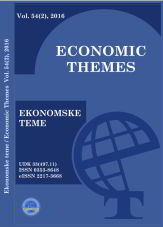Economic Themes (2016) 54 (2) 3, 217-232
Jadranka Đurović-Todorović, Marija Vuković
Abstract: The paper evaluates the size of the cyclical and structural components of the fiscal deficit of the Republic of Serbia for the period from the first quarter of 2002 to the second quarter of 2014. The method of the European Central Bank was used, where it is assumed that cyclically sensitive elements of state are budget income tax, profit tax, value added tax on the value, excises, social security contributions and unemployment benefits. Elasticity of cyclically sensitive elements relative to their macroeconomic bases are estimated using the VEC model with error correction. The results suggest that automatic stabilizers generally played a more prominent role than consistent countercyclical discretionary fiscal policy, which means that the discretionary measures were late or were not well targeted.
Keywords: cyclic deficit; structural deficit; GDP
EMPIRICAL EVALUATION OF THE FISCAL POSITION IN SERBIA
Jadranka Đurović-Todorović, Marija Vuković
Abstract: The paper evaluates the size of the cyclical and structural components of the fiscal deficit of the Republic of Serbia for the period from the first quarter of 2002 to the second quarter of 2014. The method of the European Central Bank was used, where it is assumed that cyclically sensitive elements of state are budget income tax, profit tax, value added tax on the value, excises, social security contributions and unemployment benefits. Elasticity of cyclically sensitive elements relative to their macroeconomic bases are estimated using the VEC model with error correction. The results suggest that automatic stabilizers generally played a more prominent role than consistent countercyclical discretionary fiscal policy, which means that the discretionary measures were late or were not well targeted.
Keywords: cyclic deficit; structural deficit; GDP

